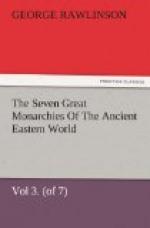Among the religious customs introduced by the Magi into Media there are one or two which seem to require especial notice. The attribution of a sacred character to the four so-called elements—earth, air, fire and water—renders it extremely difficult to know what is to be done with the dead. They cannot be burnt, for that is a pollution of fire; or buried, for that is a pollution of earth; or thrown into a river, for that is a defilement of water. If they are deposited in sarcophagi, or exposed, they really pollute the air; but in this case the guilt of the pollution, it may be argued, does not rest on man, since the dead body is merely left in the element in which nature placed it. The only mode of disposal which completely avoids the defilement of every element is consumption of the dead by living beings; and the worship of the elements leads on naturally to this treatment of corpses. At present the Guebres, or Fire-worshippers, the descendants of the ancient Persians, expose all their dead, with the intention that they shall be devoured by birds of prey. In ancient times, it appears certain that the Magi adopted this practice with respect to their own dead; but, apparently, they did not insist upon having their example followed universally by the laity. Probably a natural instinct made the Arians averse to this coarse and revolting custom; and their spiritual guides, compassionating their weakness, or fearful of losing their own influence over them if they were too stiff in enforcing compliance, winked at the employment by the people of an entirely different practice. The dead bodies were first covered completely with a coating of wax, and were then deposited in the ground. It was held, probably, that the coating of wax prevented the pollution which would have necessarily resulted had the earth come into direct contact with the corpse.




